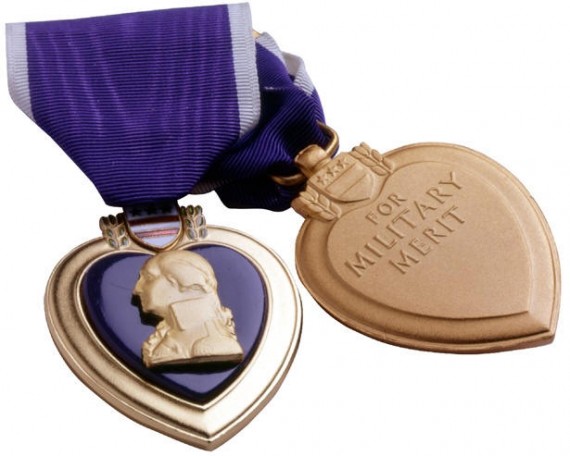Fort Hood Victims Awarded Purple Heart
Nidal Hasan’s victims were finally awarded the Purple Heart yesterday.
CSM (“Fort Hood shooting: why it took five years to award victims Purple Hearts“):
More than five years after psychologist Nidal Hasan, then a US Army major, went on a shooting spree killing 13 people and wounding 30 others, the military victims of his rampage received Purple Hearts in Fort Hood, Texas, Friday.
The medals were a long time coming. That’s because initially, the gunshot wounds sustained by the victims were considered “workplace injuries” by the Department of Defense.
It was a rider included in the 2015 defense budget that expanded the parameters for Purple Heart eligibility, reclassifying the victims’ injuries as the result of an attack inspired by a terrorist group, rather than a workplace injury. Since its inception, the medal’s most basic requirement has been that recipients be injured at the hands of an enemy.
The medal ceremony this week, and the latest legislation that allowed the Purple Heart awards to move forward, reflect the new realities of war, says Phillip Carter, director of the Military, Veterans, and Society Program at the Center for a New American Security.
“We’ve entered a more complex era where we don’t just fight overseas, but at home, too,” he says. “There’s no principled reason to divide the victims of 9/11 from Fort Hood from some victims in Baghdad.”
Had, for example, an Al Qaeda-inspired attack occurred in Kuwait or Iraq, there might have been some brief debate that probably would have come to the same conclusion in far less time than five years, adds Mr. Carter, who served in the Army as a civil affairs officer in Iraq and is also an adjunct professor of law at Georgetown University in Washington.
I’m not sure I agree with Phil on this. As I noted back in 2012 (“Purple Heart for Fort Hood Victims?“), while I fully expected the award once Hasan was convicted, the shooting spree falls outside the traditional scope of the award.
Those killed at the Pentagon on 9/11 were so honored and there’s no obvious distinction between the two groups, other than the fact that Hasan is an American citizen. That’s not a trivial distinction, since the Purple Heart award criteria continually use the words “foreign” and “international
[…]
The Fort Hood victims are technically in a gray area. While Hassan considered himself part of al Qaeda, it’s not clear that he actually was. And, since there wasn’t an ongoing firefight with an enemy force, his murder spree isn’t really “friendly fire,” either.
There have been several other instances where “lone wolf” nutbags shot and/or killed service members stateside and no Purple Heart was awarded. Still, I have no real heartburn with the award. Since we’ve long changed the criteria to include victims of terrorist attacks (a response to the 1983 Hezbollah bombing of the US Marine barracks in Beirut), it’s really legalistic parsing at this point. Indeed, as I noted two years ago (“Army Denies Purple Heart to Fort Hood Victims (For Now)“) I presumed the Army would make the decision on its own once Hasan was convicted and had only avoided doing so already to avoid creating undo command influence on the court martial panel.

@James Joyner:
Pat Tillman got a Purple Heart (and a Silver Star), despite the Army being well aware that he had been killed by friendly fire. (Obviously a part of the cover up regarding how he was killed.)
@PJ: “Friendly fire” in a combat zone is a legit cause for award of the Purple Heart.
I don’t like this. Combat is combat.
@NIt picker: The issue is to trivial to really care, and it’s pretty much a given that an exception would be made. That said, I agree. I think there is a legitimate distinction to be made between GOING in harm’s way and happening to be in an ostensibly safe place when harm appears.